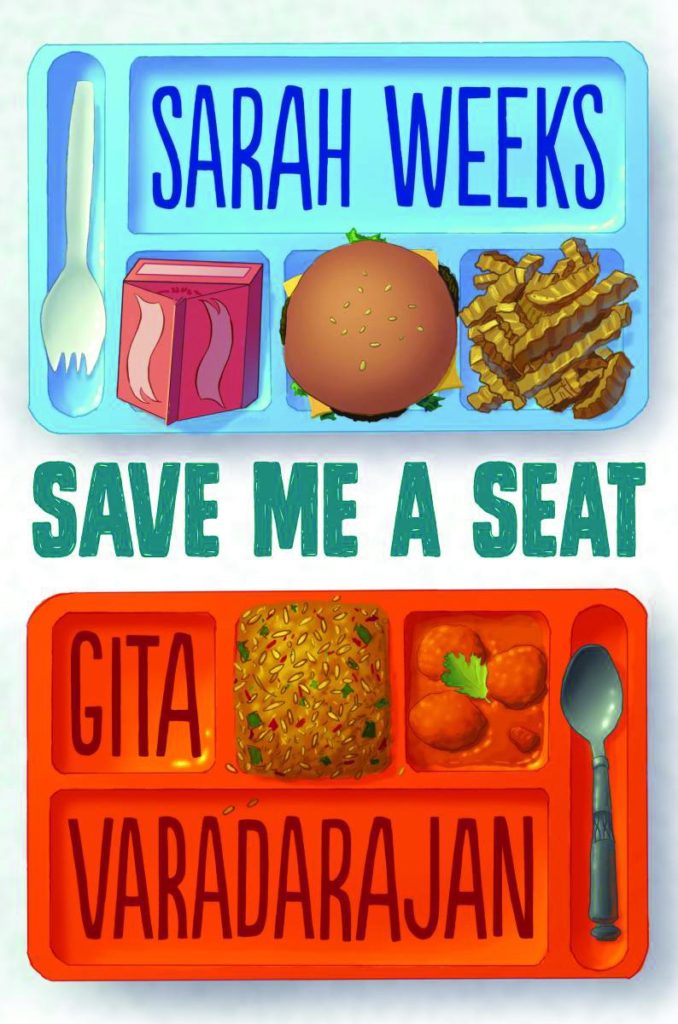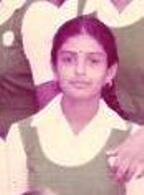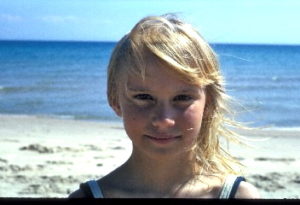Save Me a Seat Interviews
 GITA AND I REALLY ENJOYED DOING THIS INTERVIEW FOR SCHOOL LIBRARY JOURNAL…
GITA AND I REALLY ENJOYED DOING THIS INTERVIEW FOR SCHOOL LIBRARY JOURNAL…
Staying in Touch with Their Inner Tween: Sarah Weeks and Gita Varadarajan on “Save Me a Seat”
By Karen Yingling
Veteran author Sarah Weeks and newcomer Gita Varadarajan (Var-ah-da-RAH-jen) have collaborated on Save Me a Seat, a middle grade novel that addresses common middle grade fears from the viewpoints of two characters who feel they are different. They recently caught up with SLJ for a virtual lunchtime conversation about their new book.
What kind of middle grade students were you? What did you like to read?
Sarah Weeks: I was the youngest of three. My older brother and sister were excellent students, excelling at math and science in particular. I was a good student too, but my strongest subjects were English, music, and drama. I played piano and viola in the school orchestra and was in many school plays. Most of all, I loved to read and write. I remember reading My Side of the Mountain in sixth grade and To Kill a Mockingbird and Lord of the Flies in seventh grade—all three of which remain among my favorite books today.
Gita Varadarajan: I was a decent student, average, always flew under the radar, did not really attract any attention from my teachers, or peers for that matter. I was quiet and maybe even a little reticent. It sometimes felt that I had so much to say, but the words would never come out. I would play back the school scenes in my head, me saying things, speaking up, but in reality the drama always remained only in my head. I just loved the magical worlds and humor of Roald Dahl. I think every one of his books is EPIC!! But my all-time favorite book was Malgudi Days, short stories written by the most famous Indian author, R.K. Narayan. He transported me to the beautiful fictional town of Malgudi in southern India, a land of snake charmers, of sweet sellers, of color and laughter. An India I lived in, but also an India I wanted to live in. I wish I lived in Malgudi then and even now.
Most middle grade readers feel that they are “different”, so stories about characters like Joe and Ravi resonate with them. How did you feel that you were different from your school mates when you were this age, and how did that feeling help you write Save Me a Seat?
SW: I was not one of the “cool” girls in my school. I entered puberty on the late side. I wore glasses and had braces and I was flat as a board and very tall for my age. In a word—geeky. I took comfort in my writing and my music but often felt that my parents didn’t understand my creative side. I wrote a lot of tortured poetry back then. It’s embarrassing to read it now, but it saved my life during those difficult in-between years when you’re not a little kid anymore, but you’re not a full blown teenager yet either. I didn’t have the kind of learning challenges that Joe faces, but I was hopelessly lost in math class and often wondered if there was something wrong with my brain.

Gita in her tweenage years.
GV: I was definitely uncool and I felt invisible. I grew up with my grandparents, and had a very traditional south Indian upbringing. I had to dress modestly, no short skirts, short hair, or fancy jewelry. I attended an all-girls school. It was the 80s and girls were experimenting with everything. But here I was just following all the rules, which, in my mind, were archaic. I always got home on time, didn’t go to the movies or the beach…with my friends alone, never argued with my grandparents, and I pretended to work hard. My hair was long and always neatly plaited with a dab of coconut oil to keep it in place. I wore a bindi, like a good Hindu girl. I hated how I looked. Did I want to rebel, did I want to be like the other cool girls in school? Of course! But there was no way I could reason with my grandmother. I would never win that battle. So, much like Ravi, I went to school dressed conservatively, hair tied in ribbons, canvas shoes painted white, uniform ironed. Much like Ravi, I wanted to hang out with the cool gang, and much like Ravi, I was totally ignored and felt I didn’t fit in.
The humor in Save Me a Seat will entice many readers. You both seem to have a similar sense of humor. Was this a fun book to write? How did you collaborate?
SW: Yes, Gita and I laugh A LOT. We have very similar senses of humor. Our collaboration started with many hours spent on the telephone talking about our lives and our cultures. Gita and I grew up in very different surroundings, but we discovered that we have a lot in common, including the fact that we each have two sons whom our worlds revolve around. We talked a lot about our children and our own childhoods. When it came to the actual writing of the book, we developed a method that worked for us. We read our chapters aloud to each other, then we’d retreat to our separate corners to rewrite. It was a true collaboration in that we both learned how to speak and think like both Joe and Ravi. One thing that I am especially proud of about our story, and one which I think sets it apart from others, is that over the course of five days, Joe and Ravi become friends without ever having exchanged a word. Gita can tell you more about our writing process and she will probably include that I was pretty bossy!
GV: Actually contrary to what Sarah thinks, I was so pleasantly surprised by our collaboration. I was writing with a veteran, and expected all the bossiness that goes with experience, but writing with Sarah was absolutely joyful, full of laughter and light-heartedness. But it was also a very deep and emotional experience. It started off as a conversation on the page. I would write a chapter in Ravi’s voice and she would respond in Joe’s voice. Sarah was in a frenzy and she drove me to it as well. Within a week we had written the first section of our book. And the pace never let up. In the midst of it all, we talked for hours on end about everything under the sun, about our cultures, traditions, food, styles of parenting, leeches, and peanut M and M’s, all of which somehow magically found their way into our writing. As my husband Arun said, our story was a jugal bandhi. Literally translated, this means “entwined twins.” In Indian classical music, a jugal bandhi is a composition made by two soloists who have very unique and different styles, who team together, to make the most beautiful music, each respecting and responding to the style of the other. Sarah respected me, my feelings, my ideas, my views, and, most importantly, my writing. Not only had I discovered myself, I had discovered a new friend. By the time we came to the final revision process, Sarah and I could talk in Ravi and Joe’s voices, with lots of inputs from the expert and novice in each other’s writing. Through all of this, the one thing I never felt was pressure of any sort, I wrote for the pure joy of writing and for enjoying the process with someone who cared deeply about it.
I love the depiction of the parents in this book. Why do you think parents forget that middle graders usually love them but are deeply embarrassed by them? How do you stay in touch with your inner tween?

Sarah, age 11.
SW: My theory is that people who write for kids are actually still very much kids at heart themselves. I have no trouble at all connecting with my inner tween! In fact, sometimes it’s hard to disconnect from her! People often ask if I would consider writing for older readers or even adults. I wouldn’t even know how to start! I love writing middle grade. It feels like home to me. You don’t have to deal with sticky situations like….LOVE. Ugh! I mean, I love love, I just don’t want to have to write about it. As far as parents go, mine were wonderful but extremely embarrassing, and apparently my kids feel exactly the same way about me, though I can’t imagine why!
GV: Well, I remember as a middle grader, I didn’t want my parents to come to school, or meet my teachers. I especially did not want them to be anywhere in sight when I was with my friends. My grandparents, of course, had to be kept at a larger distance (remember they were like my parents, too). It’s no different with my own kids. The other day my son messaged me saying, that his friends were over and I should make myself SCARCE. I get that they are embarrassed, I was too at their age, but I still can’t figure out why? I observe my boys and their emotions closely and can constantly see how I was at their age. Plus, I work with kids, and though they are just second graders, some of them are behaving like tweens already. I guess they keep me connected to my inner tween.
Ms. Weeks, you’ve written so many books, all very different. What’s your favorite thing to write? What’s next?
SW: I’m working on two new books at the moment—a picture book called Lizzy McTizzy about an exuberant little girl who has trouble staying on task, and a novel which I can’t really talk about yet, except to say it’s a book I never thought I would write. I’ve also been really busy working on the movie of So B. It. It’s finished now and I’m thrilled to report absolutely lovely! I have heard many tales of woe from authors who felt their stories were lost or even ruined in the translation to film, but I couldn’t be more pleased with the way the So B. It film turned out. I will keep you posted on when to look for it in theatres—I’m told it will be very soon. I’ve also just finished collaborating on a screenplay based on my book, Pie. I guess I’ve been bitten by the Hollywood bug.
Ms. Varadarajan, there are many interesting Indian and Indian American writers. Who are some you would recommend to middle grade readers? Why does food seem to figure so largely in books by Indian authors?
GV: I’ve most recently read Tiffin by Mahtab Narsimhan and love the way she takes readers to Mumbai and the famous Dabbahwallas. I’ve also read Uma Krishnaswami’s The Grand Plan to Fix Everything which I thoroughly enjoyed. Both these stories take you to India, and give you a window into life there.
We Indians love our food and we show our love through food. If you do get invited to an Indian household for a meal, be prepared for a very sumptuous, elaborate, and of course delicious meal. And you will be forced to eat, for we take feeding our guests seriously. Food plays the biggest role in our festivals, weddings, and every single social occasion, even a simple everyday meal. Well, it’s not so simple, really. I guess that even though there is so much of variety and diversity in our food, with every state in the country boasting its special cuisine, food is also the one thing that bonds us as Indians. And so is it any surprise that food would show up in our writing?
What would your middle school lunch table look like if you could have lunch with any literary or historical characters? Which characters would be more likely to sit with you? Are there any who would probably turn up their nose at your invitation?
SW: Hmmmmm. I’m not a big history buff, so eating lunch with George Washington or Napoleon Bonaparte would be completely wasted on me. Literary figures I would love to eat with would include Wilbur and Fern from Charlotte’s Web (Wilbur would love a middle school lunchroom, don’t you think?) and Scout from To Kill a Mockingbird. I don’t think I’d want to eat with the gang from Lord of the Flies. I have a feeling they would have a food fight. Since I wasn’t a cool kid in middle school, the question is…would anybody want to eat with ME? I think Gita and I would have been friends if we’d known each other in middle school. She claims that she was shy back then, but that is hard to believe. She is such a firecracker now, she lights up the room wherever she goes! BTW, my favorite lunch in junior high (which is what we called middle school back in my day) was butter sandwiches and chocolate milk. Pretty Midwestern, eh?
GV: Well, I think I would want to eat lunch with Swamy from R.K. Narayan’s Malgudi Days. I know most readers may not know him, but I would definitely want to be friends with Swamy, though I am not sure if he would be shy around girls. George from Roald Dahl’s George’s Marvelous Medicine, too might join, considering how smart he was in inventing that medicine. We’d have a lot to talk about, especially dealing with annoying adults. Though the farmers Boggis, Bunce, and Bean from Fantastic Mr. Fox are villains, I kinda like the sound of their names, and they would be hilarious to eat with—though they may be plotting to get rid of us. Julian from Enid Blyton’s Famous Five might pass a lot of judgement about me on account of me being a girl, so I think he might turn his nose at my invitation. Sarah, I’m sure will have so much fun with such a mad bunch. So what will we eat? That’s tricky considering the motley crew. But, I had yogurt rice and lime Indian pickle packed in a tiffin box everyday for lunch and I loved it, so I guess I can share it with everyone.
I always tell my students that I would ask Anthony Horowitz’s Alex Rider, but I don’t think there is any way that he would actually come and sit at my table! He’d have much cooler people with whom he would eat!
